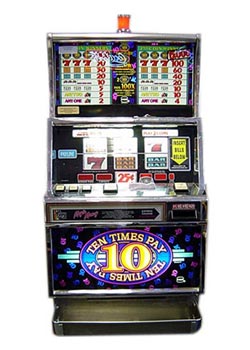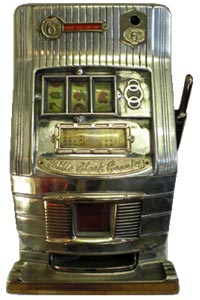The slot machine as we know it today has evolved over time from the first Sittman and Pitt poker gambling machine produced in 1891 to the fancy electronic machines of today. The original machines consisted of five drums holding a total of 50 cards. The ten of spades and the jack of hearts were removed to reduce the chance of players getting a royal flush which gave the highest pay out.
The machines were very popular and could be found in most bars in New York where it originated. Customers would put a nickel in the machine, pull a handle, and any wins would be paid out in free drinks, cigars or what that particular bar was offering.
Four years later the first true slot machine was invented by Charles Fey of San Francisco. Fey reduced the number of reels in his machine to three, this was in order to devise an automatic pay out system which the original poker machine could not do due to the vastness of winning combinations.
The Charles Fey machine had five symbols which were diamonds, spades, hearts, horse shoes and a liberty bell. The Liberty Bell or Bell machine took off like wild fire and was soon in bars, cigar stores and brothels all over the United States. The original Liberty Bell machine is still housed at the Nevada State Museum in Carson city.
The slot machine got its name from the slot where a player would put their money in, but they have since had a whole host of ‘nick names’, and one of the most common one is, a one armed bandit, which came about from the machine having a lever on one side of the machine – this was of course the “one arm”, and bandit because most of the time players would lose their money and walk out penniless, as if being robbed.
With the progression of these machines, they also became commonly known as fruit machines as the symbols on the reels were often depicted various fruits. In Australia and New Zealand they are referred to as ‘Pokies’ which is the slang for a poker machine. Slot machines are by far the most popular form of gambling in casinos making up on average about 70% of the casinos income.
The first fully electromechanical slot machine was developed in 1963 by Bally and called ‘Money Honey’. This machine had a bottomless hopper and had an automatic pay out of 500 coins without the need of an attendant. Soon the ‘arm’ or ‘lever’ were no longer required on the machines as pushing a button was a lot simpler.
In 1976 the Las Vegas based Fortune Coin Company co. had a group of five technologist produce the first true video slot machine, and after some cheat proof modifications it was approved by the Nevada state gaming commission. The company was bought by International Gaming Technology in 1978.
In 1994 Australia had developed a game called ‘Three Bags Full’, which allowed a second screen bonus round. In this game the screen changed to a different game where additional pay outs could be won or accumulated.
At this stage there are two basic forms of machine. One is the mechanical type where the reels spin, and the other is a slot where this is done by video machine. The reel slot machine has either 3 or 5 pay lines, where as the video type machine can have anything from 9 to 243 pay lines.
A few years ago, multi denomination slots hit the market allowing players to select the amount wagered on each spin, and today customers have a choice of putting cash in the slot or the use of a card which is loaded with credits bought. Winnings are transferred to the card and if you are lucky to be a winner, winnings are redeemed at a cashier window.
All slot machines today are geared with Random number generators. What this means is that the machines are constantly generating random numbers at hundreds or thousands per second. As soon as the play button is pushed the most recent number determines the result, which means the result is dependent on when the machine is played, thus alleviating the possibility of a player finding out the sequence of any machine.
Most machines are programmed to pay out between 82-98% of the money wagered. The percentage paid out is written into the software programme at the factory which has a tamper evident seal, and may only be changed in the presence of GAMING BOARD OFFICIAL (USA)
An added incentive is linking slot machines together and having a progressive jackpot which is generally far higher than on a single machine. In this process each machine that is linked contributes a small amount to the progressive jackpot.
Australia’s gaming machines, as they are officially called are often referred to as poker machines or pokies. In 2010 there were over 200 000 Pokies in Australia, which was 2.75% of the total gaming machines world-wide. Gaming laws vary from State to State, with the most relaxed being New South Wales and the strictest being Western Australia. Gaming machines were made legal in NSW in 1956 and are not only in casinos but pubs, clubs and sports or recreational clubs. On a per capita basis Australia has about five times as many machines as the USA. More than half of the $4 billion collected in taxes comes from machines in the pubs and clubs. Australia ranks seventh behind Japan, USA, Italy, Spain, Germany and the UK in the number of gaming machine available.

Modern Slot Machine

Old Slot Machine
